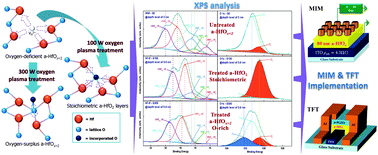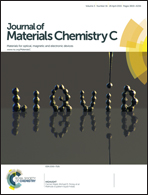The role of oxygen plasma in the formation of oxygen defects in HfOx films deposited at room temperature
Abstract
We investigate the oxygen-related defects induced in sputtered amorphous HfOx thin films through oxygen plasma treatment. This study is devoted to the development of a room-temperature process to fabricate high-performance metal–insulator–metal (MIM) capacitors and thin-film transistors (TFTs) deposited on a glass/flexible substrate. Oxygen originating from the plasma can act as a source to control the surface composition of the HfOx film. X-ray photoelectron spectroscopy analysis shows that different plasma powers stimulate different layers of stoichiometry within the films, which are represented by Hf 4f and O 1s core-level variations in terms of binding energy and peak broadening. The stoichiometry on the surface improves the quadratic voltage coefficient and frequency dispersion of the capacitances, whereas deepening the stoichiometry enhances the leakage current density, device uniformity and breakdown field strength. Recipes for the fabrication of both MIM and TFT devices through a simple-processed plasma treatment at low temperatures are provided. Herein, we demonstrate HfOx-based devices encompassing a MIM capacitor with low-frequency dispersion and a voltage nonlinearity of 12 ppm V−2 as well as an a-IGZO TFT with a mobility of 21 cm2 V−1 s−1, a threshold voltage of 2.66 V, an Ion/Ioff ratio of 1.09 × 107 and a subthreshold swing of 0.258 V dec−1.


 Please wait while we load your content...
Please wait while we load your content...